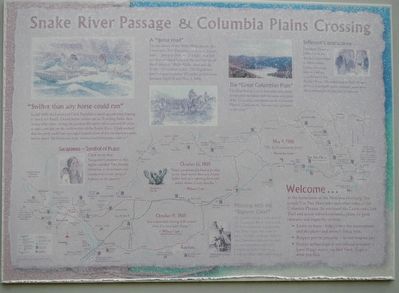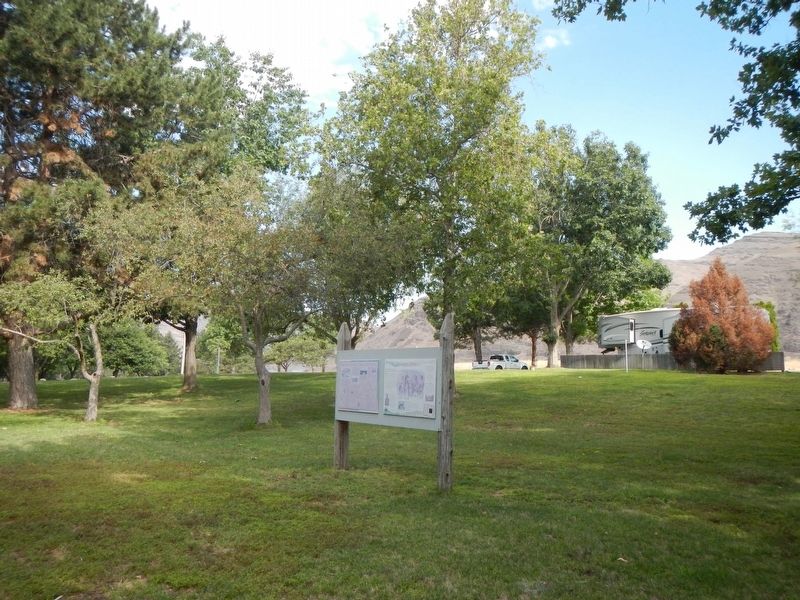Near Clarkston in Asotin County, Washington — The American West (Northwest)
Snake River Passage & Columbia Plains Crossing
Inscription.
In fall 1805, the Lewis and Clark Expedition raced against time, hoping to reach the Pacific Ocean before winter set in. Traveling faster than at any other time during the journey, the party often covered 30 mies or more per day on the swift water of the Snake River. Clark wished that the party could have portaged around more of the treacherous rapids, but he knew "the Season was so far advanced and time precious with us."
Sacagawea - Symbol of Peace
Clark wrote that Sacagawea's presence in this region signaled Our friendly intentions, as no womean ever accompanies a war party of Indians in this quarter."
A "good road"
On the advice of the Walla Walla people, the Lewis and Clark Expedition followed " a good road...plenty of Deer and Antilopes" that led travelers overland between the confluences of the Columbia / Walla Walla rivers and the Snake / Clearwater rives. The Expedition travels approximately 100 miles on this route between April 30 and May 5, 1806.
The "Great Columbian Plain"
The Expedition had its finest and completely unexpectedly encounter with the semi-arid plain of the Columbia, now known as the Columbia Plateau. Clark wrote, not one stick of timber on the river."
Jefferson's Instructions
President Thomas Jefferson wrote detailed instructions to Meriwether Lewis, directing him to lead an expedition to the Pacific Ocean. He asked him to find "the most direct & practicable water communication across this continent for the purpose of commerce.
October 16, 1805
Great quantities of a kind of prickley pares, much worst than any I have before Seen of a tapering form and attach themselves by bunches." ~ William Clark ~
October 18, 1805
"saw a mountain bearing S.W. conocol form Covered with Snow." ~ William Clark ~
May 4, 1806
The Soil is extreamly feritile" ~ Meriwether Lewis ~
Meeting with the "Bighorn Chief
On Paráha Creek, a tributary of the Tucannon River, Lewis and Clark encountered a prominent Nez Perce chief who wore the horn of a bighorn sheep under his arm. Historians believe this chief's son and grandson were also prominent leaders known as Looking Glass (elder and younger).
Welcome to the homelands of the Nimiipuu (meaning "the people") or Nez Perce tribe and other tribes of the Columbia Plateau. As you travel the Lewis and Clark Trail and across tribal homelands, please be good stewards and respectful visitors.
• Leave no trace - help protect the environment and the plants and animals living here.
• Respect private property - do not trespass and
• Protect archaeological and cultural resources - leave things were you find them. Report what you find.
Erected by Washington State Parks.
Topics. This historical marker is listed in these topic lists: Exploration • Native Americans • Waterways & Vessels. A significant historical date for this entry is October 18, 1805.
Location. 46° 24.944′ N, 117° 11.578′ W. Marker is near Clarkston, Washington, in Asotin County. Marker can be reached from Silcott Road near U.S. 12. Located in Chief Timothy Park on Silcott Island. Touch for map. Marker is in this post office area: Clarkston WA 99403, United States of America. Touch for directions.
Other nearby markers. At least 8 other markers are within 8 miles of this marker, measured as the crow flies. Álpáwayma Village (here, next to this marker); Temuut'su (approx. one mile away); Lewis & Clark Historic Trail (approx. 3.6 miles away); Lewis and Clark Enter Washington (approx. 5.3 miles away); Lewis and Clark (approx. 6.9 miles away); Granite Lake Park (approx. 6.9 miles away); Lewis & Clark Almost Slept Here (approx. 6.9 miles away); Nimiipuu Homelands (approx. 7.3 miles away). Touch for a list and map of all markers in Clarkston.
Credits. This page was last revised on November 4, 2020. It was originally submitted on November 4, 2020, by Barry Swackhamer of Brentwood, California. This page has been viewed 224 times since then and 26 times this year. Photos: 1, 2. submitted on November 4, 2020, by Barry Swackhamer of Brentwood, California.

